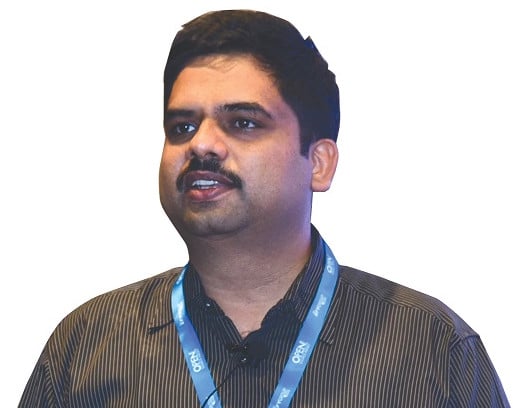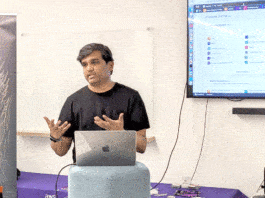Though everyone knows about free and open source software (FOSS), and the vast and diverse community that has grown around it, there is still a lot of confusion when it comes to who can contribute to it. A common question is, “Who can contribute?” To understand how the FOSS world operates in India and learn about the new projects, Ankita K.S. from the EFY Group chatted with Rajesh Sola, education specialist, KPIT, at OSI Days 2018. Excerpts follow…
Q Can you tell us about your journey with open source software?
My open source journey started as a small contributor at Novell on OpenOffice.org (LibreOffice now). This was in my final year of internship at Novell’s Linux Development Group (LDG), where I was supporting open source development on OpenOffice.org, Evolution, GNOME and a few more projects. From there on, it has been a happy journey in which I have learned a lot from FOSS, and have been able to motivate many students towards Linux migration and the adoption of open source.
Q What are your views on open source adoption in India?
Adopting open source has proved to be very successful for many organisations. We see significant trends of open source adoption in academia, government, product startups, and large corporates. The fears and risks associated with open source have gone with the enhanced community support and with the help of third party service providers.
One reason why some companies are still hesitant is that open source software does not come for free unless it is an out-of-the-box solution. There will be some costs for the human resources required to customise and maintain the software. But when compared to proprietary solutions, open source is far less expensive, allows better scaling for deployments and eliminates any vendor dependence. This is why we see more companies moving towards open source today.
Q Who can contribute to open source? What is the main challenge when it comes to getting more contributors?
You need not be a developer to contribute to open source. While developers contribute code, there are various other requirements like documentation, translations and design. So, depending on one’s skills, there is always room to help.
We can see three main types of contributors in the open source domain. One is the student community, the second covers small scale organisations or startups, and the third is the large scale organisations or established corporates. Many product startups and established firms are doing their best to contribute to open source. A few have revenue models linked to open source contributions, which is a good thing, because when contributions are paid for, it motivates more people. The main challenge is in increasing open source awareness and motivating the students in particular. They should understand that a few open source contributions highlighted in their profiles will appeal much more to recruiters than the mention of certifications or papers published.
Q Tell us about the key trends in the Indian developer ecosystem.
In India, we are very diverse when it comes to technology. Some recent trends in various market segments are cloud computing, data science, artificial intelligence, cyber security, etc. The industrial and automotive segments in the country are also adopting open source on a large scale now. Digital transformations as well as connected and smart devices are also a key trend these days.
Q Do you see India as a contributor or consumer of open source?
This is a tricky question. Though it is very difficult to quantify the amount of contributions from a particular region, India’s contributions are less compared to how much open source software we consume. Many startups and established firms are doing their best to raise awareness about open source, and are motivating students and developers to contribute.
Q Can you tell us about a few important open source projects that came up in the past few years?
There are many open source projects that have changed the development trends drastically in the past few years. For example, Docker and Vagrant allow rapid development. Many open source software play a vital role in embedded systems and IoT application development. Among these, Eclipse Kura is a powerful gateway solution for connected devices. It is a great solution for the development activities in the Eclipse IoT ecosystem.
Q How do you view the adoption of Eclipse Kura in the IoT industry?
Gateways like Kura come into the picture only for the large scale deployment of IoT applications. When IoT applications are targeted at a small user segment, developers are not keen on such gateways or choose a customised gateway solution offered by cloud providers which limits them to that application domain. Since we are facing challenges like sustainability and standardisation in the consumer IoT segment, gateways like Kura are a great fit for the Industrial IoT segment, initially—considering its scalable deployments. Eclipse Kura also is a scalable bridging solution between devices and cloud platforms. This can be the best fit for Industry 4.0 applications with significant additions for field protocols, cloud services and connectivity.
Q What are the various built-in services and what makes Eclipse Kura different?
Eclipse Kura offers good integration between embedded systems and the enterprise, and is a perfect solution for merging OT with IT (operational technology with information technology). It provides a rich set of APIs for sensing, peripheral access, wireless connectivity like Bluetooth, geo-positioning, cloud and data connectivity, industrial and automotive communication protocols like Modbus, OPC-unified architecture (OPC-UA), etc. It also enables powerful administration through remote management and configuration services.
I have written small add-ons (called bundles) for connectivity with InfluxDb, a time series database, REST Client Services and CANBus last year. I still need to enhance the code and publish it to the Eclipse marketplace (https://github.com/rajeshsola/kura-addons).
Q Where do you see the Indian open source community heading with all these new technologies entering the picture?
With hackathons, meetups, opensourceforu.com, OSFY magazine and conferences like OSI Days becoming popular, more contributors are stepping out and discussing open source. The community is growing bigger each day. More students and developers are motivated to join the community, and we hope to see India doing well as a contributing nation soon.




